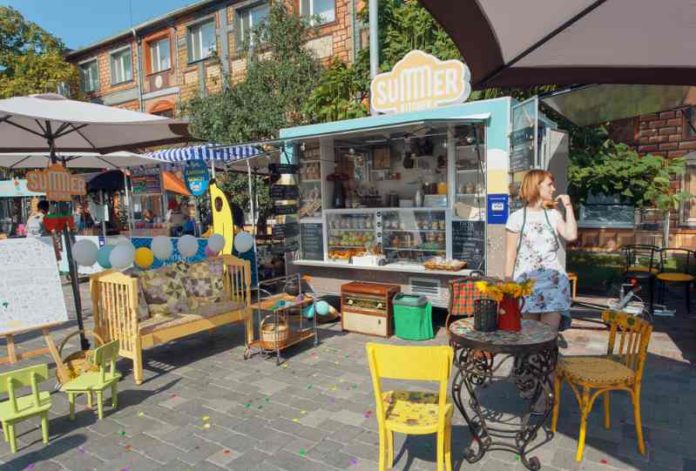By Kevin D. Johnson, Jr.
Foot Traffic, Challenges, and Technology
The heavy influx of online shopping has presented brick-and-mortars with the daunting task of coming up with ways to attract people to their physical stores. Creating the adequate amount of foot traffic needs to cover inventory, as well as other business expenses. This can prove to be a great challenge in today’s business landscape. Some stores lean heavily on technological innovations such as the “just walk out” technology- that may use cameras and sensors to track what people are removing from the shelves. Once the customer leaves the store, money is deducted from their preregistered store account. Other ideas include interactive mirrors in the dressing room that will allow the shopper to communicate with the store’s employees. They can request different colors and/or sizes they desire be brought to them. These interactive mirrors also could show the clothing in different lighting conditions and make suggestions of other items that a customer might be interested in.
Building customer’s interest in visiting a storefront is one of the biggest challenges a brick-and-mortar owner can face. Traditional considerations should still be a part of the decision-making process such as the organic foot traffic, seeking an area that has the targeted market, accessibility, etc.
Pop-Up Prospects
Having an accessible storefront that allows space for another company to set up a pop-up can provide a positive impact. There are many companies that have a strong online following but do not have a physical store. Today, many brands travel the country with their apparel, for example, looking for locations to host their pop-ups. This can be an opportunity for a brick-and-mortar to capitalize on. Photographers, painters, musicians, authors, and chefs can all benefit from a physical store.
Approaches
A store that is easily pop-up accessible is attractive to the pop-up market. Having a system in place allows pop-up conversion easy and seamless. The revenue generated is great for business. It is more beneficial if the pop-up’s targeted market is the same as the clientele of that brick-and-mortar. This can open economic opportunities for both businesses. Furthermore, if there is a connection between the pop-up’s attendees and what the brick-and-mortar carry, purchases can be made at that time as well. Some might even return later.
With social media being so popular and influential, many will post about events they attend and/or businesses they visit. Some attendees provide their location information, hashtags, and even tag the hosting store. The idea is that some of their followers will share a common interest. This can possibly increase customers. The more accessible your business-the better. People can’t find what that they aren’t aware exists.
Marketing for Pop-ups
Making people aware of the services you provide is the driving force behind success with this strategy. There are several websites that provide information on various pop-up locations all over the country. This is a good avenue to promote brick-and-mortar information, with pictures, store hours, etc. Posting on social sites, such as Instagram, can be beneficial. You should have a “Story” entitled and dedicated to your pop-up market. Providing the “when’s” and “where’s” of these pop-ups is a must! Over time, traditional posts can be pushed further to the bottom of the company’s page. In an Instagram Story, however, the content is always at the top and followers can see the title. It also gives a company a chance to spread the word two different ways. A few video clips on IGTV (used for video clips longer than one minute) can be helpful. Having a Pinterest board, using other social media sites and blogs devoted to the pop-up experience can be positive as well.
Customers via The Pop-Up
Once the new customer comes to the location the positive experience must continue. The usual customer service etiquette is always required–greeting and engaging the customers, answering questions, and being helpful–making the entire experience both enjoyable and accommodating. This includes making sure the brick-and-mortar accepts progressive payment options. Consumers have developed certain shopping expectations, this carries over into the check-out process as well. Providing options of one-way Near-Field Communication (NFC) which allows phones and payment terminals to communicate with each other by making transactions when in close proximity–like Apple Pay® and Samsung Pay ®, will greatly benefit a store. Many shoppers are steering away from traditional credit cards. If the pop-up shop’s tactics are effective you will able to capitalize on this. Once accustomed to making transactions in a certain way, people look for that continuity in their shopping experience-regardless of the industry.
Conclusion
The reality is: Shopping will always be! The ways in which we shop is where the concern lies. Truthfully, new challenges will be ever present, but there will also always be answers. This could include technological expansions or a revised marketing plan. What is most important is the result. It will take time and effort, but when things start to improve, think of ways to build on your concept. The integration of progressive technology is a huge piece to the puzzle. The other thoughts will have to come out of the box.
Kevin D. Johnson, Jr. is the founder and CEO of NorthStarr Media Group; he is an educator, as well as the creator of NorthStarr Classic Apparel. Follow at @northstarrmedia.
Pop-up store stock photo by Radiokafka/Shutterstock







